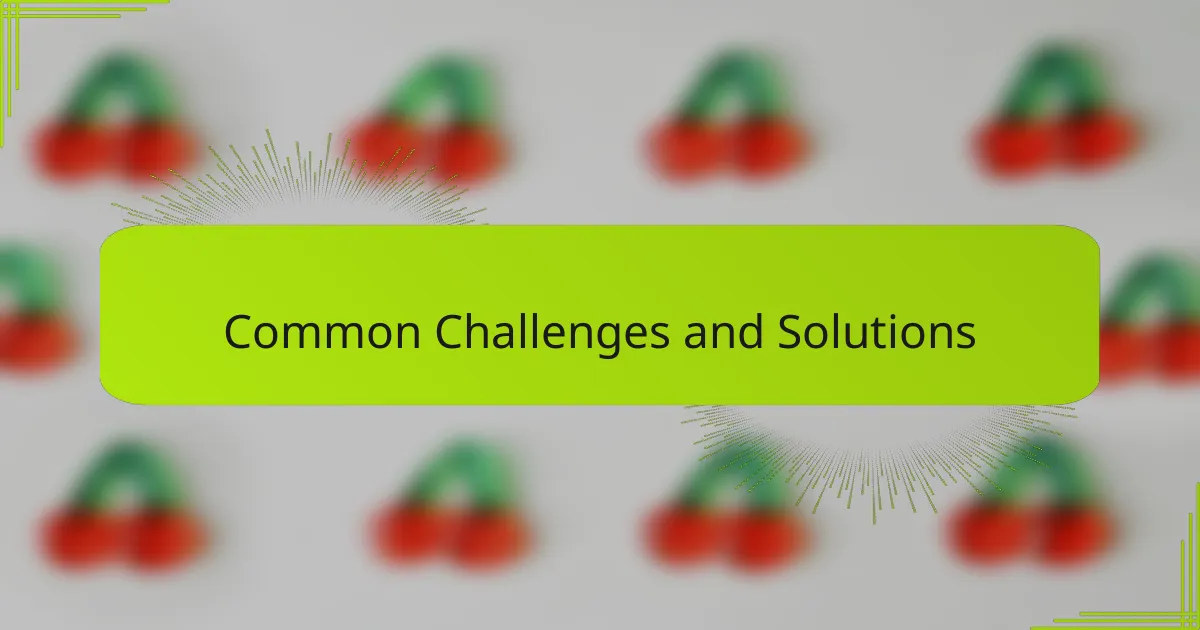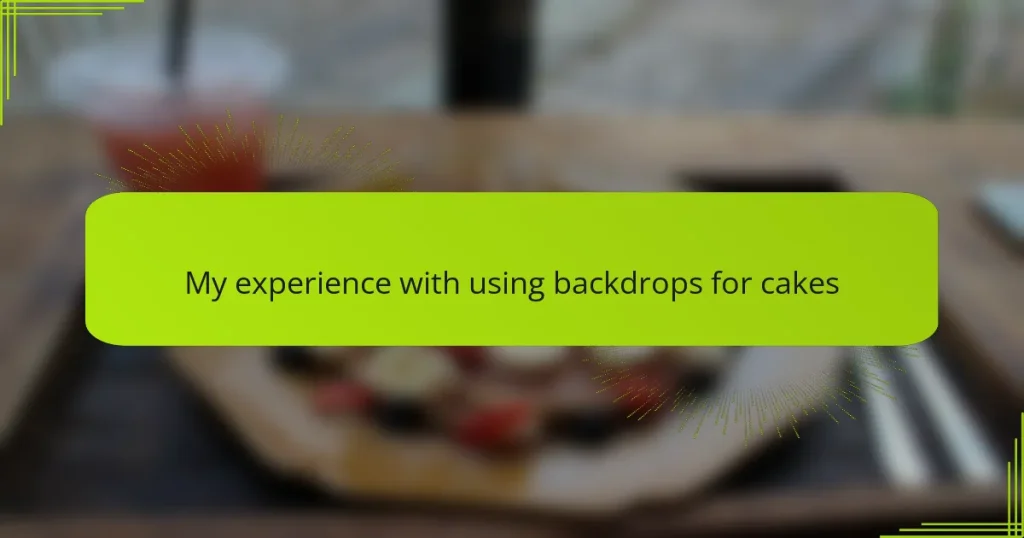Key takeaways
- Choosing a simple backdrop can effectively enhance a cake’s presentation without overpowering it.
- Lighting is crucial for cake photography; natural light and the right angle can bring out the cake’s details.
- Texture and color temperature of the backdrop should complement the cake to create a harmonious display.
- Flexibility in setup allows for adjustments to lighting and arrangement, optimizing the overall presentation.

Understanding Cake Backdrops
When I first heard about cake backdrops, I honestly wasn’t sure what to expect. Are they just fancy decorations, or do they actually enhance the dessert experience? Over time, I realized they are much more than simple backgrounds—they set the entire mood and theme for the cake.
From my experience, a cake backdrop isn’t just about aesthetics; it tells a story. It frames the cake in a way that brings out its colors and textures beautifully. I remember once using a pastel floral backdrop that transformed a plain vanilla cake into a centerpiece worthy of any celebration.
Have you ever wondered how much a well-chosen backdrop can change your perception of a cake? It’s fascinating to see how the right scene can elevate even the simplest dessert, making it feel special and thoughtfully presented. This insight made me appreciate the art behind cake backdrops much more.

Choosing Backdrops for Desserts
Choosing the right backdrop for desserts can feel overwhelming at first—I know I struggled to find something that complemented my cakes without overshadowing them. I learned that simplicity often works best; a subtle pattern or soft color can highlight the dessert’s details without competing for attention. Have you ever noticed how a bold, busy backdrop can distract rather than enhance? That’s exactly what I wanted to avoid.
One time, I experimented with a rustic burlap backdrop for a chocolate cake. The texture added warmth and made the rich tones pop, creating a cozy vibe that guests loved. This experience taught me that the material and style of the backdrop can influence not just the look, but the entire mood of the dessert display.
I also realized it’s important to think about the event when choosing backdrops. A bright, playful backdrop suits birthday celebrations, while elegant linens work better for formal occasions. Asking myself, “What feeling do I want to evoke?” helped me pick designs that felt meaningful and tailored to the moment.

Setting Up Backdrops for Cakes
Setting up backdrops for cakes was initially a bit tricky for me. I found that securing the backdrop in a stable position without wrinkles really made a difference; loose or creased backgrounds distracted from the cake’s elegant design. Have you ever tried using clips or a simple frame to hold everything smoothly? That small step elevated the whole presentation in my experience.
I also learned to consider the lighting when arranging my backdrop. Natural light brought out the colors beautifully, but harsh shadows sometimes ruined the effect. Once, I moved the setup closer to a large window, and it instantly highlighted the cake’s details against the backdrop—something I hadn’t expected but now always keep in mind.
Another thing I discovered was the importance of scale and proportion. At times, my backdrop felt too large or too busy for the cake size, overshadowing it rather than complementing it. I started visualizing the final shot beforehand, asking myself, “Does this backdrop let the cake shine or steal the spotlight?” That mindset helped me create balanced, eye-catching displays every time.

My Techniques for Using Backdrops
One technique I’ve found invaluable is layering textures within the backdrop to add depth without overwhelming the cake itself. For example, combining a matte fabric with subtle metallic accents created a dimension that made my lemon drizzle cake practically glow, without stealing focus. Have you ever thought about how texture can quietly enhance a visual story? It really changes the way a cake is perceived.
Another approach I swear by is matching the backdrop’s color temperature to the cake’s tone. Warm shades like soft peach or cream seem to bring out richer tones in spiced cakes, while cooler hues like icy blues make chocolate cakes pop. I remember one time I picked a cold grey backdrop for a carrot cake and immediately felt the whole display was a bit too stark—it taught me to trust my instincts on color warmth.
Lastly, I always consider how adjustable my setup can be; I keep lightweight backdrops that are easy to move and reposition. This flexibility saved me countless times when lighting conditions shifted unexpectedly during photoshoots. Have you ever been caught off guard by fading daylight? Having that mobility made a big difference in capturing my cakes at their absolute best.

Tips for Enhancing Cake Photos
One thing I’ve learned is that lighting can make or break your cake photos. Have you ever taken a picture where the colors look dull or the shadows are harsh? Moving closer to natural light or even using a simple reflector to soften shadows can instantly elevate the entire image, making the cake’s textures and details pop in a way that studio lights sometimes can’t replicate.
I also pay close attention to the angle and distance when photographing cakes. Getting too close can blur important details, while shooting from too far away might lose the cake’s intricate decorations. Finding that sweet spot—usually a slightly elevated angle that captures both the top and the sides—has always helped me share the cake’s story more clearly through my photos.
Lastly, don’t underestimate the power of simplicity. A cluttered background or too many props can distract from your masterpiece. In fact, I often recommend limiting extras so the cake remains the star of the shot. Have you noticed how a clean, gentle backdrop can make the colors and shapes of your cake truly shine? That minimalism, combined with thoughtful lighting and angles, has transformed my cake photos more than any fancy equipment ever did.

Common Challenges and Solutions
One common challenge I faced was dealing with creases and wrinkles in fabric backdrops. At first, I underestimated how much these small imperfections could distract from the cake’s appearance. Have you ever noticed how a wrinkle in the background pulls your eye away? Using a simple steamer or even stretching the fabric tightly helped me achieve a smooth, polished look that truly let the cake shine.
Another hurdle was balancing the backdrop size and pattern with the cake itself. I recall a time when my backdrop was overwhelmingly large and busy, and instead of enhancing the cake, it nearly swallowed it whole. It made me realize how crucial it is to ask, “Does this backdrop support the cake or overpower it?” Choosing more subtle prints and proportionate sizes became my go-to solution for achieving harmony.
Lighting changes also posed real challenges. I remember setting up a beautiful backdrop only to have harsh shadows spoil the shot. Moving the setup near a window with soft natural light transformed the whole scene instantly. Have you experienced that magic moment when lighting suddenly makes everything come together? It’s one of those simple adjustments that made a big difference in my cake presentations.

Lessons Learned from Backdrop Use
One lesson that stood out to me is how crucial it is to keep the backdrop’s simplicity in mind. I once chose a backdrop with a busy floral pattern, thinking it would add charm, but it ended up stealing the spotlight from my carefully decorated cake. Have you ever experienced that frustration when your backdrop just doesn’t let the cake shine? Since then, I always remind myself that less is often more.
Another important insight came from understanding the interaction between backdrop material and lighting. Early on, I overlooked how reflective surfaces could create unwanted glare, making the cake look less appealing on camera. It took a few trial-and-error moments before I realized that matte fabrics often give a nicer, more consistent look. Do you ever find yourself adjusting the setup multiple times to fight against harsh reflections? That’s part of what helped me grow.
Finally, I learned that patience and flexibility are key. Not every backdrop behaves the way I expect, whether due to wrinkles, awkward sizing, or light shifts throughout the day. I remember staying late one afternoon, rearranging and repositioning my backdrop to catch that perfect soft glow. It taught me that persistence really pays off—if you’re willing to tinker and adapt, your cake will look stunning every time.




